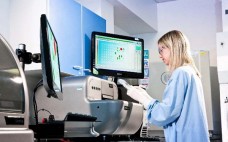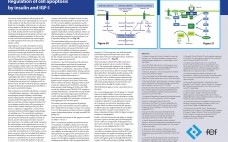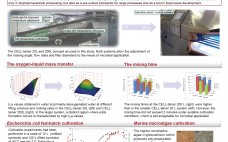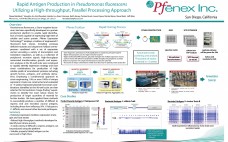Recombinant monoclonal antibodies (MAbs) maintain their ranking as the best-selling class of biologic drugs. The introduction of high titer bioprocessing for the majority of these MAb products has focused efforts towards maintaining desired quality attributes and reducing time to market. Furthermore, patents covering several blockbuster MAbs and the expression technologies, which facilitate their high-level expression, are due to expire over the next decade. A wave of second generation or “follow-on” biopharmaceuticals/bioprocesses will therefore be vying for market share and regulatory approval. Consequently, should biopharmaceutical manufacturing companies rely on traditional “platform” methods of cell line development (CLD), which are well known but yield extensive variation and unpredictable stability of expression, or invest in emerging technologies, which offer the potential of greater reproducibility and speed? Enabling technologies in this area include host cell engineering, engineered expression vectors, and rapid transient gene expression. Given the well-known mantra “the product is the process”, implementation of these disruptive technologies will require a thorough understanding of how changes at the CLD-phase affect key production process characteristics such as high cell-specific productivity, correct product processing and rapid cell proliferation. Traditionally, CLD optimisation is carried out using a lengthy trial-and-error approach where cells are treated as a “black box” and characteristics are iteratively improved. Further advancement in CLD is therefore likely to benefit from the tools of systems biology. These tools will ensure that future CLD manipulations will be informed by an understanding of the genetic, regulatory, and metabolic networks that determine key process characteristics during a production process.
Upstream Processing
Regulation of cell apoptosis by insulin and IGF-I
An increase in the number of cells growing in cell culture is the result of two opposing effects: an increase in the number of cells that traverse the cell cycle and divide into two daughter cells (mitosis), or a decrease in the number of cells that die according to different modalities, the most prominent one being apoptosis (1), or both. Insulin and IGF-I are both capable of facilitating cell progression through the cell cycle, and of inhibiting apoptotic mechanisms. In…
Process Improvements Increase Production Capacity of a Legacy Product
Implementation of postlicensure process improvements in the biopharmaceutical industry can benefit patients and drug manufacturers alike. Here we demonstrate through a case study how a change to the cell culture medium and process can be taken from proof of concept through scale-up to demonstration of feasibility. We further illustrate the scope and complexity of implementing a change in commercial manufacturing to realize significant benefits such as increased production capacity over an existing legacy process. The Importance of Postapproval Improvements Drug…
Impact of Process Interruption on Virus Retention of Small-Virus Filters
Manufacturers of biopharmaceuticals using mammalian cell culture must have processes in place to minimize the likelihood of virus contamination of their products. Regulatory agencies provide guidelines for testing strategies and best practices to assure raw-material safety and control of the manufacturing process. Safety assurance relies on an interdependent matrix of managed risks, including characterization and control of raw materials, extensive testing of process intermediates, and demonstration of the virus removal capabilities of purification unit operations Figure 1: () A dedicated…
Enhancing Antibody Production
Increasing demand for monoclonal antibodies (MAbs) — useful as immunodiagnostic reagents in basic research applications and potential immunotherapeutics — has created a need to optimize protein production techniques. Many developers have attempted to increase MAb output from cell culture by addressing both equipment and consumables. For example, recent advances in improved bioreactor designs and bioreactor operation have increased antibody outputs by increasing cell densities and extending cell life in culture. Materials and Methods () Bioreactors can operate in batch, perfusion,…
Six Essential Workflow Steps for Paperless, Automated, End-to-End Environmental Monitoring
The consequences of microbiological contamination range from FDA warning letters through product quarantines and recalls all the way to plant shutdowns. This makes quality control, specifically microbiological and environmental monitoring (EM) a mission-critical priority for pharmaceutical and biotechnology drug manufacturing operations.
Are you currently struggling with integrating a home-grown, paper-based or semi-automated EM system to your LIMS only to find out that it’s error-prone and resource hungry? Are your current LIMS or IT systems over extended when it comes to customizing automated, paperless, mobile data capture and workflow management for EM? Are you searching for a proven, best-practices approach to automate EM and LIMS workflows and reporting in a cGMP environment without hindering new product development and production?
This whitepaper provides an overview of the essential workflow steps for implementing a paperless, automated, end-to-end environmental monitoring solution to increase productivity, reduce compliance risk and generate a healthy return on investment.
Microbial Cultivation In Different Scales in the CELL-tainer® Rocking Single-use Bioreactor
Single-use bioreactors are applied in the biopharmaceutical industry for mammalian cell culture processes. The low gas-liquid mass transfer coefficient generally achieved in these systems does not allow for the compatable application of microbial processes in these bioreactor systems. The CELL-tainer® technology combines a vertical and horizontal movement in a rocking bioreactor concept, so that the turbulence and power input is intensified. In this system, mass transfer rates comparable to stirred tank reactors are achievable. Thus, volumetric oxygen transfer rates (kLa)…
A Systematic Strategy of Cell Culture Media and Feed Development
Development of a high-performance and robust fed-batch process for recombinant Chinese Hamster Ovary (CHO) cell lines presents challenges in light of the diverse nutritional requirements observed with different clonally derived cell lines as well as the varied production phases. To address these challenges, we will discuss an innovative strategy of media, feed, and process development that has been developed at FUJIFILM Diosynth Biotechnologies (FDB). The efficiency and effectiveness of this strategy have been well demonstrated in multiple mAb-producing CHO cell…
Continuous Bioprocessing: A CMO’s Perspective
The maturation of many process industries is marked by transition from batch to continuous processing. Often this move to con-tinuous processing determines the winners in the industry. Will the bioprocess industry go the same way? The analogy is often drawn to the chemical industry where continuous processing is widely applied. Although available for many decades continuous bioprocessing is not yet a mainstay of the industry. Currently there is a ground swell of feeling within the bioprocess industry that the time…
Rapid Antigen Production in Pseudomonas fluorescens Utilizing a High-throughput, Parallel Processing Approach
Pseudomonas fluorescens, a Gram-negative bacterium, has been specifically developed as a protein production platform to enable rapid identification of strains capable of expressing high titers of soluble and active protein. PfÄ“nex Expression Technology (TM) employs a toolbox of engineered P. fluorescens host strains, including protease deficient mutants and chaperone/ foldase overexpressors combined with a set of expression vectors encoding a variety of transcription and translation regulators, as well as a collection of periplasmic secretion signals. High-throughput automated transformation, growth, and…







